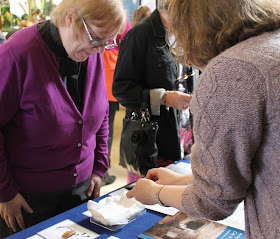The Beau Street Hoard project is moving on apace! The project team is busy developing the application for the Heritage Lottery Fund. This involves many different elements, from liaising with external partners and public consultation to working out how to move a rather inconveniently placed gas pipe which runs through the area where we propose to install the new lift for a fully-accessible gallery.
 |
| A Beau Street Hoard Project meeting |
There are many aspects to consider for the curators, designers and the facilities team (who look after the building here at The Roman Baths), as they plan how to incorporate the Beau Street Hoard display into the Aquae Sulis gallery: environmental control, lighting, display mounts and how the display will be interpreted - for example - through text panels, graphic illustrations and multi-media. Visitor flow must also be factored in – we want our visitors to be comfortable, so we need to ask how they will move around and access the new display. This process involves re-positioning existing exhibits, as well as up-dating signage. It is a complex business, but well worth it to have the Beau Street Hoard on show as part of our permanent collection.
We have been working closely with Event Communications, an exhibition design company, who have designed the redisplay of the museum over the past six years. Daniel Warren is the senior designer working with us to display the Beau Street Hoard to its best advantage within the gallery. Daniel describes one idea they have: ‘We imagined an array of coins rising up out of the ground in an intriguing pattern. Closer inspection will reveal they are arranged in very loose groupings through which we can explore aspects of Roman money. Mounts will be minimal and the coins will appear to float within the case. In this way, the overall feel of the display will be light, airy and mobile, rather than a heavy clump of coins in an uninspiring pile.’
Currently, we are consulting members of the public, both in the museum and off site, as to what sort of display they’d like to see, so we can incorporate their ideas into the final design.
The story of the Beau Street Hoard’s discovery in Bath will also be told within the display. Interpretation will include text-based panels and an audio visual exhibit demonstrating the fascinating conservation process undertaken by our partners in the British Museum Conservation Department.
 |
| Part of the Beau Street hoard display in the British Museum |
Watch this space for updates and if you haven’t seen the hoard, come and see our free, temporary display in the Sun Lounge of the Roman Baths or, if you’re closer to London, pop in to see the display in the Citi Money Gallery at the British Museum.
Saira Holmes – Project Officer


















